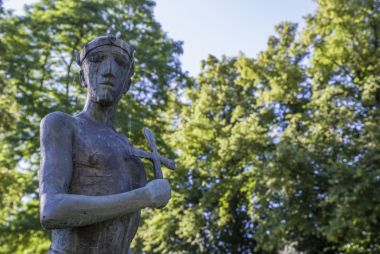
BY : Neil Rees Christian Today
The 23rd April is St George’s Day but St George was not the original patron saint of England, so who was? This is the story …
The original patron Saint of England
St George was known in Anglo-Saxon England, and was mentioned by the Venerable Bede. There were also some Saxon churches dedicated to St George, but St George was not the original patron saint of England.
King Edmund
The original patron saint of England was in fact St Edmund, also called Edmund the Martyr, or St Edmund King and Martyr, who had been King of East Anglia in the 9th century. What we know about him comes mainly from the Anglo-Saxon Chronicle, and from the later writings of a French monk called Abbo of Fleury. According to Abbo, his source was St Dunstan, Archbishop of Canterbury, who had heard the story from an old man who had been Edmund’s sword-bearer.
East Anglia
Before England was unified in the tenth century, it was a patchwork of kingdoms of the Germanic tribes of the Angles and Saxons. The eastern Angles formed the Kingdom of East Anglia, which was the easternmost part of southern England. This included the North Folk (now called Norfolk) and the South Folk (now called Suffolk). Even today this area is still known as East Anglia.
Edmund was born in the year 840 or 841, and succeeded to the throne of East Anglia in 854 or 855, after the death of his father King Æthelweard. Edmund was only fifteen years old when he was crowned on Christmas Day by Humbert, Bishop of Elmham.
Martyr
King Edmund was a Christian, who had reputedly learnt the whole Psalter by heart. In 869 he fought alongside King Alfred of Wessex against the Viking and Norse invaders, which the Anglo-Saxon Chronicle referred to as the Great Heathen Army.
When his forces were defeated, Edmund was captured near Thetford by Ivar Ragnarsson, which translates as Ivar the Boneless. Edmund was ordered to renounce his faith and share power with the pagan Vikings, but he refused.
He was killed by the Danes on 20 November 869, after refusing to renounce Christianity. The story goes that after being tied to a tree and shot full of arrows he was then beheaded. He was then succeeded as King of East Anglia by King Oswald
Edmund’s tomb
According to Abbo of Fleury, Edmund died at Haegelisdun, which was near to where he was killed. It is not known for sure where this is, but one theory is that it might be modern day Hellesdon in Norfolk, and another theory is that it is Hailesdon near Maldon in Essex. Another tradition is that it is Hoxne in Suffolk, where there is a monument which claims to mark the spot of his death. He was then buried nearby in a wooden chapel at a place called Suthtuna, which is Sutton in modern English, although again no-one is completely sure which Sutton.
Bury St Edmunds
In 902, Edmund’s remains were moved to Beodericsworth in Suffolk. In 925, King Athelstan founded a religious community to care for Edmund’s shrine. After King Canute became a Christian he ordered a new stone abbey to be built over the site, which was completed in 1032. The Abbey of St Edmunds became one of England’s major pilgrimage sites. Pilgrims came from all over Europe to the abbey, and the town is known to this day as Bury St Edmunds.
Patron Saint of England
England had a number of saints which were considered patron saints, but St Edmund was the main one. The banner of St. Edmund was carried into battle by the English army into mediaeval times. However by the time of King Edward I, at the end of the thirteenth century, his banner had been joined by the red cross banner of St. George.
Demoted by St George
In 1346, St George was credited with helping England to win the Battle of Crécy in France. In 1348, King Edward III of England, created a new order of chivalry called the Noble Order of the Garter, which still exists today. King Edward III made St George the patron of the Order, and also declared him Patron Saint of England instead of St Edmund. After that time, the cross of St George became associated with England, and was later adopted as its flag.
St Edmund’s Day
Edmund’s shrine was destroyed in 1539 during the dissolution of the monasteries. St Edmund is a saint in the Catholic Church, and is also remembered in the Church of England.
There are many churches dedicated to St Edmund. The most well known is probably St Edmund the King and Martyr’s Church in Lombard Street in London. The original was burnt down in the Great Fire of London and the current one was designed by Sir Christopher Wren and completed in 1679.
Traditionally saints’ days are remembered on the day they died rather than the day they were born (which is less likely to be known) and so St Edmund’s Day is on 20 November, the date of his martyrdom. The collect for St Edmund’s Day is “Eternal God, whose servant Edmund kept faith to the end, both with you and with his people, and glorified you by his death: grant us such steadfastness of faith that, with the noble army of martyrs, we may come to enjoy the fullness of the resurrection life; through Jesus Christ your Son our Lord, who is alive and reigns with you, in the unity of the Holy Spirit, one God, now and for ever. Amen.”
Photo: Getty/iStock


















